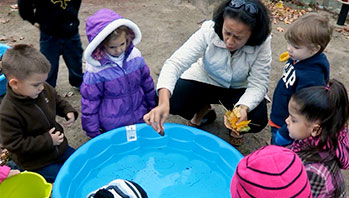- camera
- chart paper
- clipboard
- marker
- paper
- listen
- loud
- predict
- quiet
- sound
MA Standards:
Speaking and Listening/SL.PK.MA.1: Participate in collaborative conversations with diverse partners during daily routines and play.
MA Draft Standards:
Physical Sciences/Matter and Its Interactions/PS4.A: Investigate different sounds made by different objects and different materials and reason about what is making the sounds. [Cause and Effect]
Head Start Outcomes:
Logic and Reasoning/Reasoning and Problem Solving: Recognizes cause and effect relationships.
PreK Learning Guidelines:
English Language Arts/Language 2: Participate actively in discussions, listen to the ideas of others, and ask and answer relevant questions.
Science and Technology/Living Things and Their Environment 15: Use their senses of sight, hearing, touch, smell, and taste to explore their environment using sensory vocabulary.
Explore Together (outdoors): Outdoor Listening

© Commonwealth of Massachusetts, Department of Early Education and Care. All rights reserved.
STEM Key Concepts: Sounds have a source; An action has to happen to make a sound; Sounds vary in three ways: volume, pitch, and timbre; Different objects make different sounds
ELA Focus Skills: Compare and Contrast, Speaking and Listening, Vocabulary
Safety Tips:
- Be aware of and check areas for poison ivy, poison sumac, and bushes with thorns before taking children outside.
- Remind children to wash their hands before and after the activity.
- Children's allergies need to be taken into account before going outside.
Have children think about the sounds they heard earlier. Ask volunteers to describe a sound they heard and tell where they heard it.
- Make the sound of a bird or a car honking or another outdoor sound children will recognize. Ask, Where do you usually hear a <bird chirping, car honking>? (outside)
- Say, Today we will go outside to listen for sounds. But before we go outside, let’s make a list of sounds we think we might hear. What sounds do you predict you will hear when we go outside? Have children use the terms loud and quiet as they dictate, write, or draw their predictions on the chart paper. Then go outside, taking clipboards and markers for children to dictate or record observations.
Once outside, gather children and sit quietly and listen to the sounds all around. After one minute, ask questions such as,
- What sound do you hear?
- Have you ever heard a sound like that before? Where?
- What do you think is making that sound?
Allow children to explore different areas within your view. Encourage them to explore with a partner and record (dictate, draw, or take photos) their observations as they listen for sounds.
Reflect and Share Together
Once inside, discuss children’s observations and compare the list of predicted sounds with the list of sounds that the children actually heard. Ask,
- Were there any sounds you thought you would hear but didn’t?
- What surprised you about the sounds that you did hear?
